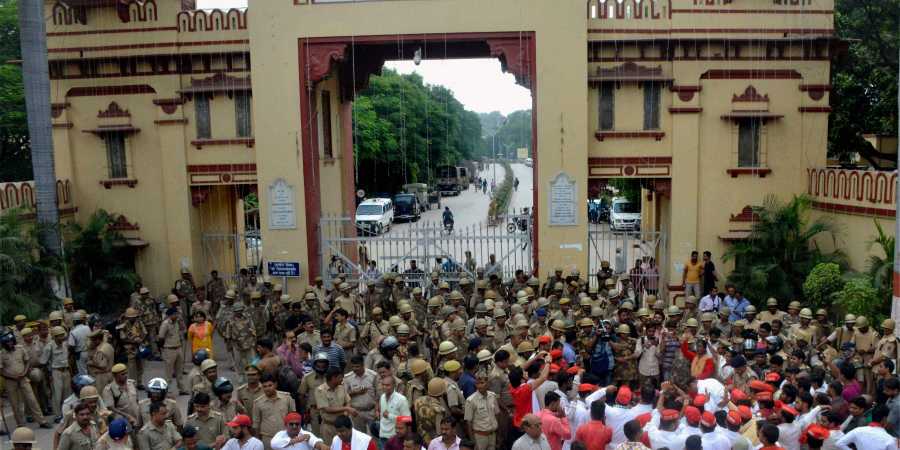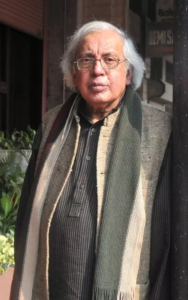Minakshi Rajdev
Who is Firoz Khan? What is his identity in Indian society? How did he develop an interest in learning the Sanskrit language? Is it because of something beyond the narrow peripheries of religion but a reason which is deeply rooted in the culture of India?
Firoz Khan, the newly appointed assistant professor in the Banaras Hindu University belongs to the Dhadhi, Hindu-Islamic community of Rajasthan. Dhadhis are traditional bards, musicians and genealogists living in northern parts of India like Punjab, Haryana, Rajasthan and Gujarat. Agricultural Hindus and tribes like Jasts, Rayaka-Rabari, Bishnoi, Khatri and Chhippas are their traditional patrons.
According to the Marwar Census Report of Rajasthan in 1891, Dadhis are followers of both Islam and Hinduism who trace their origin to Rajput families from the time of Ram. The Report records a popular couplet or doha which is still evoked by the community,
Dasrath ke ghar ram janamiya has dadhan mukh boli,
Athara kiror le chawk meliya kaam karan ko chhori
(‘Ram was born in the house of Dashrath, said a dhadhi woman
Leaving all work aside, she started singing songs of his birth.’)
From the popular origin story of yore to the present times where a singular religious identity dominates, Dadhis have preserved the century-long tradition of a composite, syncretic culture of India. Their identity is testament to an order where Hinduism and Islam are not antagonistic to each other.
When it comes to Firoz Khan’s appointment as Sanskrit professor, it is imperative to answer questions posed by the protesting students of the University and supporters of the protests at large.
Why should a Muslim be allowed to teach Sanskrit at an institute with Hindu religious precedence?
Dr. Firoz Khan was appointed faculty of the Sanskrit Vidya Dharma Vijnan. Protesters said that in the same way that a Hindu cannot attain the education to become a maulavi, or imam or even a Christian priest, a Muslim or ‘non-Hindu’ can have no right to become a professor of Sanskrit, especially at a place where Sanskrit is taught to produce future shastris and perform rituals.
This question, however, lacks in basic reasoning.
Unlike priests or imams of other religious orders, a professor of Sanskrit at BHU would play a role in the preservation and development of ancient and traditional knowledge by keeping pace with modern patterns of learning. His role would not be limited to producing mere machines of rituals which are considered to come under the paradigm of Hinduism.
Besides, Firoz Khan was appointed to the department of literature which has no direct hold over ritual practices.
What about the Hindu calendar published by BHU?
The second major concern raised by the protesters is that the Faculty of Vidya Dharma Vijnan publishes the Vishwa Hindu Pnachangam which is the Hindu calendar, based on Vedic astrology.
Its authenticity would be affected, protesters argue.
The major point of ire raised here is that it would set precedence for the appointment of more non-Hindu faculty members in the department of Sanskrit.
The ‘fear’ expressed here is that many more Muslims would find a way to the Sanskrit department and would gather strength to raise qualms on of authority of the Hindu calendar, which allegedly affects the larger Hindu population across the world.
The right wing politics of ‘sentiments’ develops upon the field of ‘fear’ of losing the integrity of ‘faith’ with the inclusion of non-Hindus in the teaching-learning practices of Sanskrit.
Sanskrit, however, is not the religion but one of the mediums of languages in which Hindu religious scriptures are written.
Teaching Sanskrit literature and making the Hindu calendar are separate functions. More importantly, the Hindu calendar is not made by the divine insight of Brahmins, but instead is designed on the basis of the lunar month and weather of India.
Thus the ‘politics of sentiment’ and the ‘politics of hurt’ is a right wing narrative imposed on BHU to polarise students of the campus on communal lines, establish political advantage of the ‘Hindu’ faith over any other religion living in India, and distract the protests of students over a fee hike.
A cultural attack?
Can it be believed that the future of Hindu ancient religious practices depends upon the appointment of teachers in the modern university space for one of the oldest languages of the world? And can Brahmanism be considered the saviour of this alleged cultural attack by Muslims on the BHU Sanskrit department?
Periyar once said that between a snake and Brahmanism, Brahmanism is more poisonous. It is not a ‘cultural attack’ in the way it is being propagated, but it is a Brahmanical attack on peaceful coexistence of religions in India.
Akbar, Jahangir and Shahjahan gave special attention to the development of the language and it would be unjust to not include Aurangzeb in the list. Shayasta Khan, maternal uncle of Aurangzeb, was noted poet of Sanskrit language who even wrote a treatise called Rasakalpadruma. Other noted Sanskrit poets of the time like Devdatta, author of Gurjarishakatam, acknowledged Aurangzeb and his son Azam Shah in the opening lines of the treatise.
Mohammed Hanif Khan Shastri is the most recent example of a Muslim Sanskrit scholar who was awarded with fourth highest civilian award of the country, Padma Shri (literature and education) in 2019 by President Ramnath Kovind for his immeasurable service to the nation as professor of Sanskrit at the Rashtriya Sanskrit Sansthan. He also won the National Communal Harmony Award in 2009
The politics of language replaces language with religion to create anxiety over fragile identity politics driven by a ‘politics of hurt’.
Does cultural Hinduism strengthen political Hindutva?
The invented ‘precariousness’ of the Hindu religion tries to establish a direct link between ‘cultural Hinduism’ and the political ideology of ‘Hindutva’ nurtured by VHP and RSS.
It is this soft communalism or cultural Hindutva which reaches a wider section of the society and sows the seeds for spreading stronger communal hatred.
The narrative constructed by the protestors of BHU are based on soft Hindutva ideology, but is essentially based on the popular communal ideas according to which Islam, ‘a religion of violence’ and Hinduism, a religion of peace can never share the same place. Besides, the appointment of a non-Hindu would dismantle the predominance of Brahmins in the working of the Sanskrit department.
Was Hindutva the fundamental idea behind the Banaras Hindu University?
It is also important to delve into the history of the Banaras Hindu University where ‘H’ doesn’t represent the politically driven perspective of Hinduism. BHU stands on the southern outskirts of Banaras at the bank of the Ganges.
Pandit Madan Mohan Malviya, with the vision of spreading scientific education and rationality, left his legal practice and focused upon the development of the university which he formally announced at the 21st session of Indian National Congress in December 1905.
On November 22, 1911, the Hindu University Society was registered by Malaviya with the support of Annie Besant. He spent a few years to raise funds for the actual foundation of the university.
With persistence, he could wield the support of few princely states and nobles such as Kashi Naresh Prabhu Narayan who gave land at the southern outskirts of the present day Varanasi; the Raja of Darbhanga state, Maharaja Sir Rameshwar Singh Thakur; and the last Nizam of Hyderabad, Mir Osman Ali Khan who donated Rs 1 lakh for the construction of the university.
The foundation stone of the university was laid by the Sikh saint of the time, Baba Attar Singh ji of Punjab in 1914.
I now come back to the original matter of discussion. A university which was constructed with a vision and contribution of various personalities of the time comes to a point where religion is evoked for the appointment of an assistant professor.
If religion is the deciding factor of the country’s education system and language becomes the battle ground of communal battle against identities, I believe that even gods can’t save the people of this country.
Looking at the increasing saffronisation of educational institutes, the repercussions are not just limited to the destruction of the liberal structures of the societies, but it is the threat to the century-old composite traditions of India or South Asia at large where variegated religious, ethnic and linguistic identities have lived with each other and developed a distinct cultural field of shared heritage.
Several syncretic identity groups like Dadhis, Mirasis, Manganiyars and Langas who have carried this tradition through generations are now under constant attack from dominant political narratives of religions.
An anonymous poet from the same community expressed the dilemma.
Vahid tang nazar ne mujhe kafir mana,
Kafir samajhte hain ki musalman hu mai
(‘The narrow sight of the world labelled me a Muslim
And the Muslims treated me as Hindu’)
Retrospectively, the Indian education system and philosophy is based on the secular notions of learning, and therefore the development of the institutions of learning are based on inclusivity of various caste, creed, religion, gender or class.
Protests against the appointment of the Dr Firoz Khan at Banaras Hindu University not only exhibits right wing political propaganda for further polarisation but is also an attack on composite culture.
(Minakshi Rajdev is a PhD scholar at the Centre for Historical Studies, Jawaharlal Nehru University.)




